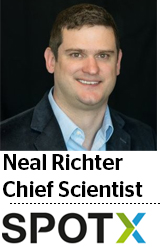 Neal Richter, who spent two years as Rakuten Marketing CTO, is headed to SpotX as the company’s first ever chief scientist.
Neal Richter, who spent two years as Rakuten Marketing CTO, is headed to SpotX as the company’s first ever chief scientist.
Richter is one of the early tech leaders in programmatic, helping to develop all three openRTB specs released by the IAB, as well as online ad authorization industry initiatives like Ads.txt and Sellers.json.
As chief scientist, Richter will handle SpotX’s algorithmic and machine learning technology products: work that analyzes large data sets, like auction dynamics in new video environments and campaign forecasting, which he said is critical for programmatic video because TV advertisers are accustomed to regimented media buys.
Richter will report to SpotX CTO J. Allen Dove, who Richter said he’s worked with for more than five years on IAB and IAB Tech Lab projects. The move to SpotX won’t change Richter’s work with the trade group, but he said now he’ll be focused on television and video technology road map.
It’s “a different lingo” in the world of TV and video, he said, after working primarily on digital display for the past decade.
“Video in programmatic needs standardization,” Richeter said. “And this space has the benefit of seeing and learning from the first wave of programmatic technology.”
For instance, television broadcasters and digital media companies with strong video supply embrace scarcity, eschewing the ubiquitous impressions and integrations that marked programmatic display growth, he said.
In programmatic display, the open marketplace is the primary revenue source, with alternatives like programmatic guaranteed or private marketplace deals springing up. In TV and video, the dynamic is inverted, Richter said, with private trading as the primary trading mechanism and true open programmatic marketplaces are relatively small.
“One might predict (programmatic video) would go the way of display, but I don’t think so,” he said. “Unfortunately, what we’ve seen previously is commodification, and that when every impression is available in every platform or channel it introduces security and quality risks.”
TV buyers are used to having more control and transparency over their campaigns, like knowing exactly when and where commercials run, he said. So security and display innovations that lift display media, like Ads.txt or Ads.cert, are even more important to video advertisers.
“There aren’t many independent solutions left on the sell side when it comes to video,” Richter said, because of the higher standards and the retreat into private marketplaces.
SpotX was acquired by RTL Group, the largest European broadcast station owner, and major US players like Verizon, Comcast and AT&T, after its acquisition of AppNexus, have consolidated the market.
“The bones of most supply-side systems are common,” he said. “But (transitioning to TV) will be difficult because the last mile of delivery is challenging when you’re serving an ad to TV screens and when you’re using new identifiers.”
This post was syndicated from Ad Exchanger.


More Stories
Unbound and HubSpot officially partner up
NBCUniversal, Macy’s Ink 10-Year Pact for Thanksgiving Day Parade, July 4th Fireworks
Stuff Group brings new leader for North Island on board